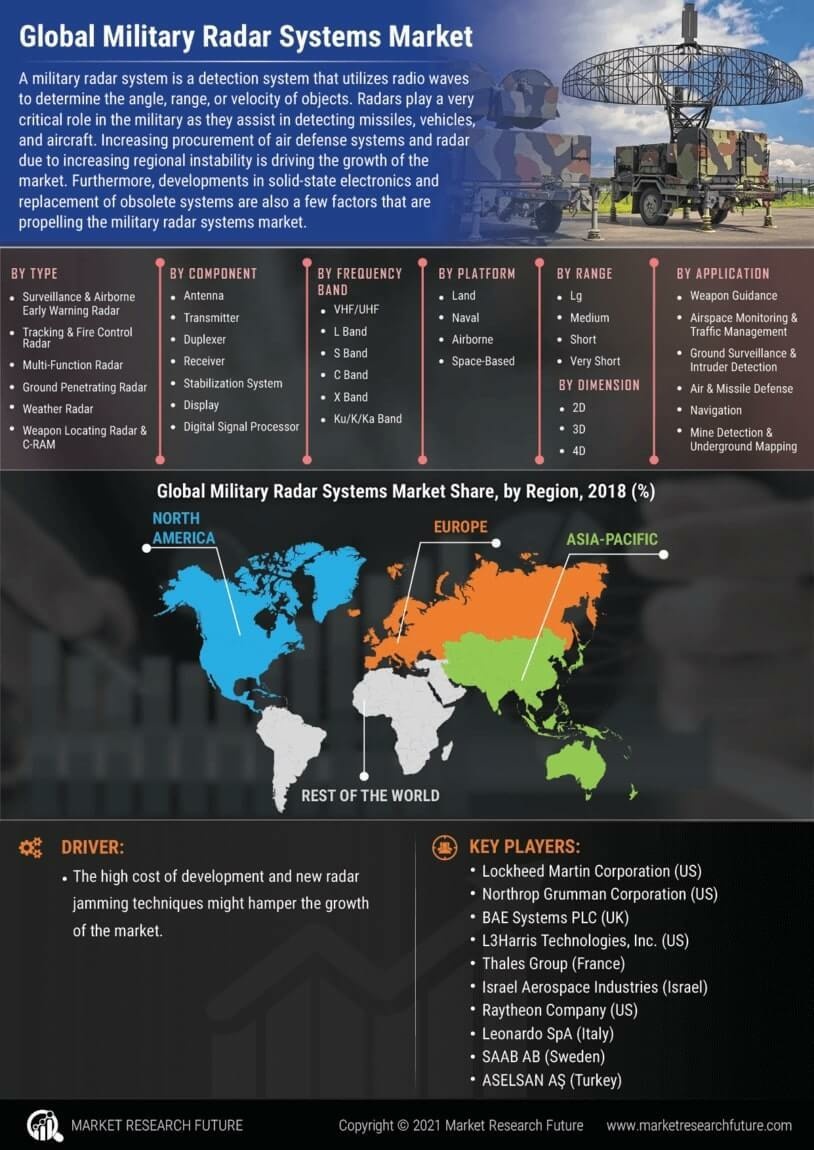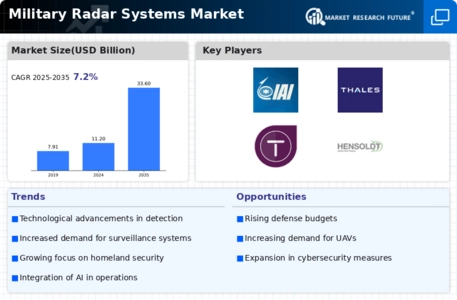Geopolitical Tensions
Geopolitical tensions around the globe are a critical driver of the Global Military Radar Systems Industry. Heightened conflicts and territorial disputes compel nations to bolster their defense mechanisms, leading to increased investments in radar technologies. For instance, ongoing tensions in regions such as Eastern Europe and the South China Sea have prompted countries to enhance their military readiness. This environment fosters a demand for advanced radar systems capable of providing real-time situational awareness. As a result, the market is projected to grow significantly, with estimates indicating a rise from 11.2 USD Billion in 2024 to 33.6 USD Billion by 2035, supported by a CAGR of 10.52% from 2025 to 2035.
Market Growth Projections
The Global Military Radar Systems Industry is poised for substantial growth, with projections indicating a rise from 11.2 USD Billion in 2024 to 33.6 USD Billion by 2035. This growth trajectory reflects a compound annual growth rate (CAGR) of 10.52% for the period from 2025 to 2035. The increasing demand for advanced radar systems, driven by technological advancements, rising defense budgets, and geopolitical tensions, suggests a robust market environment. As nations prioritize military modernization and enhance their surveillance capabilities, the radar systems market is likely to expand significantly in the coming years.
Increasing Defense Budgets
The Global Military Radar Systems Industry is significantly influenced by the increasing defense budgets of various countries. Governments are prioritizing national security and investing heavily in advanced military technologies, including radar systems. For example, nations such as the United States and China have announced substantial increases in their defense spending, which directly correlates with the demand for sophisticated radar solutions. This trend is expected to drive the market, as countries seek to enhance their surveillance and reconnaissance capabilities. The anticipated growth trajectory suggests that the market will expand from 11.2 USD Billion in 2024 to 33.6 USD Billion by 2035, reflecting a CAGR of 10.52% during the 2025-2035 period.
Technological Advancements
The Global Military Radar Systems Industry is experiencing rapid technological advancements, particularly in the areas of digital signal processing and artificial intelligence. These innovations enhance radar capabilities, enabling improved target detection and tracking. For instance, the integration of phased array technology allows for more precise and agile radar systems. As nations invest in modernizing their military capabilities, the demand for advanced radar systems is expected to rise significantly. This trend is reflected in the projected market growth, with the industry anticipated to reach 11.2 USD Billion in 2024 and 33.6 USD Billion by 2035, indicating a robust CAGR of 10.52% from 2025 to 2035.
Emerging Threats and Cybersecurity
The Global Military Radar Systems Industry is increasingly shaped by the emergence of new threats, including cyber warfare and unmanned aerial vehicles. As adversaries develop sophisticated tactics, military organizations are compelled to adopt advanced radar systems that can detect and counter these threats effectively. The integration of cybersecurity features into radar systems is becoming essential to protect sensitive data and maintain operational integrity. This shift is driving innovation within the industry, as manufacturers strive to create resilient systems that can withstand evolving challenges. The market is expected to grow from 11.2 USD Billion in 2024 to 33.6 USD Billion by 2035, indicating a CAGR of 10.52% for the period from 2025 to 2035.
Demand for Modernization of Legacy Systems
The Global Military Radar Systems Industry is witnessing a strong demand for the modernization of legacy radar systems. Many military organizations are operating outdated technologies that lack the capabilities required for contemporary warfare. As a result, there is a pressing need to upgrade these systems to enhance performance and interoperability with newer technologies. Countries are increasingly investing in modernization programs to ensure their radar systems can meet current and future operational requirements. This trend is expected to contribute to the market's growth, with projections indicating an increase from 11.2 USD Billion in 2024 to 33.6 USD Billion by 2035, supported by a CAGR of 10.52% from 2025 to 2035.

















Leave a Comment